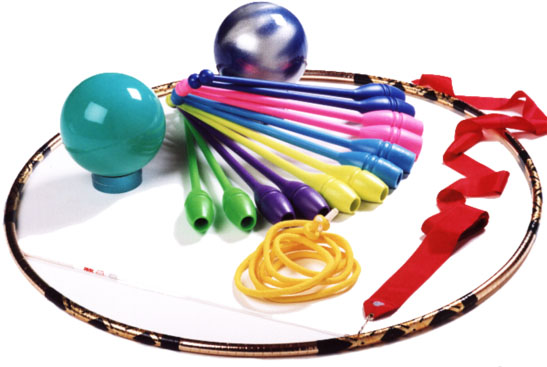 Rhythmic
gymnastics is a challenging and exiting activity for all children.
Rhythmic Gymnastics focuses on body awareness and hand-eye
coordination, team spirit, confidence building and problem solving. Rhythmic
gymnastics is a challenging and exiting activity for all children.
Rhythmic Gymnastics focuses on body awareness and hand-eye
coordination, team spirit, confidence building and problem solving.
Rhythmic Gymnastics provides children with the unique opportunity to
express themselves to music, and the chance to compete at National
and International level competitions. Rhythmic Gymnastics first
appeared during the 19th century and slowly grew in popularity until
the first experimental competitions were staged during the 1930s.
Having evolved to incorporate elements from classical ballet, German
muscle-building techniques and Swedish exercise systems, it’s one of
the most beautiful spectacles on the Olympic games.
Rhythmic Gymnastics is preformed by women only and at the Olympic
games, each country is limited to eight athletes (two Individual
athletes and a group of six athletes for the Group event).
History of Rhythmic Gymnastics at the Olympic Games:
The first World Rhythmic Gymnastics Championships were held in
Budapest in 1963, just over two decades before the discipline made
its Olympic debut at the Los Angeles 1984 Games. A Group event was
added to the programme at Atlanta 1996.One of just two
women-only disciplines in the Olympic Games (the other is
Synchronised Swimming), Rhythmic Gymnastics is a combination of
gymnastics and dance. Individual competitors perform short routines
to music using hand apparatus – a hoop, a ball, clubs and a ribbon.
Groups perform two routines, one with five balls and the other with
three ribbons and two hoops. Scores are awarded in three categories:
difficulty, artistry and execution.
During the routines the apparatus must be in constant motion, with a
variety of moves performed.
Rhythmic Gymnastics poetry in motion:
Performed mostly by women, Rhythmic Gymnastics is a discipline
combining grace, coordination, agility and artistry. Accompanied by
stirring music, the gymnast uses small hand apparatus to weave a
routine of flawless beauty moulding gymnast, music and apparatus
into one.
The handling of apparatus whilst performing complex turns, pivots,
balances and contortionist like movements are characteristic
trademarks of this intriguing gymnastics discipline.
Providing participation opportunities for individual or groups,
Rhythmic Gymnastics is the perfect sport for those with a penchant
for dance and movement to music and where personality and expression
can be nurtured over the following pieces of apparatus.
Rhythmic Gymnastics Equipment:
 Rhythmic
Gymnastics routines containing many dance and ballet characteristics
are performed to music using hand apparatus. Rhythmic
Gymnastics routines containing many dance and ballet characteristics
are performed to music using hand apparatus.
There are five pieces of rhythmic gymnastics hand apparatus: rope,
hoop, ball, clubs and ribbon. Every two years, the International
Gymnastics Federation designates four of the apparatus to be used,
and the other to be set aside for that time period.
Each event is performed on a floor mat measuring about 42.5 feet by
42.5 feet. It is not the same as the floor exercise mat used in
artistic gymnastics – it doesn’t have the same amount of spring or
padding to it. This is at the request of rhythmic gymnasts, because
it is much easier to perform the skills required on a floor without
spring and padding. |

